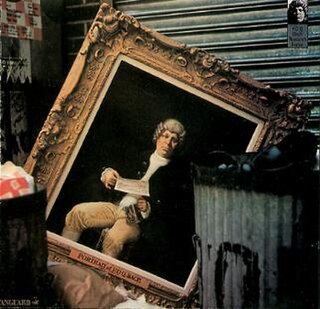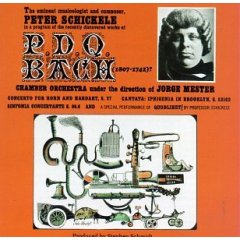The Musical Offering, BWV 1079, is a collection of keyboard canons and fugues and other pieces of music by Johann Sebastian Bach, all based on a single musical theme given to him by Frederick the Great, to whom they are dedicated. They were published in September 1747. The Ricercar a 6, a six-voice fugue which is regarded as the high point of the entire work, was put forward by the musicologist Charles Rosen as the most significant piano composition in history. This ricercar is also occasionally called the Prussian Fugue, a name used by Bach himself. The composition is featured in the opening section of Douglas Hofstadter's Pulitzer Prize winning book Gödel, Escher, Bach (1979).
Elaine Shaffer was an American flutist and principal of the Houston Symphony Orchestra between 1948 and 1953.

The Brandenburg Concertos by Johann Sebastian Bach, are a collection of six instrumental works presented by Bach to Christian Ludwig, Margrave of Brandenburg-Schwedt, in 1721. The original French title is Six Concerts à plusieurs instruments, meaning "Six Concertos for several instruments". Some of them feature several solo instruments in combination. They are widely regarded as some of the best orchestral compositions of the Baroque era.

P. D. Q. Bach is a fictional composer invented by the American musical satirist Peter Schickele, who developed a five-decade-long career performing the "discovered" works of the "only forgotten son" of the Bach family. Schickele's music combines parodies of musicological scholarship, the conventions of Baroque and Classical music, and slapstick comedy. The name "P. D. Q." is a parody of the three-part names given to some members of the Bach family that are commonly reduced to initials, such as C. P. E., for Carl Philipp Emanuel Bach; PDQ is an initialism for "pretty damned quick".
Flute repertoire is the general term for pieces composed for flute. The following lists are not intended to be complete, but rather to present a representative sampling of the most commonly played and well-known works in the genre. The lists also do not generally include works originally written for other instruments and subsequently transcribed, adapted, or arranged for flute, unless such piece is very common in the repertory, in which case it is listed with its original instrumentation noted.
The Concerto for Horn and Hardart, S. 27, is a work of Peter Schickele composing under the pseudonym P. D. Q. Bach. The work is a parody of the classical double concerto but where one instrument, the hardart, uses different devices, such as plucked strings, blown whistles and popped balloons, to produce each note in its range. The name "hardart" and the name of the concerto is a play on the name of proprietors Horn & Hardart, who pioneered the North American use of the automat. Like the automat, the hardart had small windows in the front where the musician had to insert coins to remove implements needed to strike or otherwise play the devices that produced the notes. The composer Philip Glass, a classmate of Schickele's, helped build the actual instrument; Glass and the others tasked with building the hardart made it a transposing instrument without telling Schickele. Although a parody, the work is a well-written example of a classical concerto and could stand as a serious piece of music with a few changes.

Peter Schickele Presents an Evening with P. D. Q. Bach (1807–1742)? was the first concert of and the first release of the music of Peter Schickele under his comical pseudonym of P. D. Q. Bach by Vanguard Records. The chamber orchestra was conducted by Jorge Mester. The album consists of musical parodies with commentaries by the composer.
Laszlo Varga was a Hungarian-born American cellist who had a worldwide status as a soloist, recording artist, and authoritative cello teacher.

The Wurst of P. D. Q. Bach is a collection of works by Peter Schickele under his comic pseudonym of P. D. Q. Bach originally recorded on the Vanguard Records label by the composer. It includes "lowlights" from four different Vanguard albums: An Evening with P. D. Q. Bach (1807–1742)?, An Hysteric Return: P.D.Q. Bach at Carnegie Hall, Report from Hoople: P. D. Q. Bach on the Air, and P. D. Q. Bach's half-act opera The Stoned Guest. Wurst is the German word for sausage, with the album cover photograph set in a sausage shop.
P.D.Q. Bach in Houston: We Have a Problem! is a live performance celebrating 40 years of P. D. Q. Bach. This performance features Professor Peter Schickele with Orchestra X conducted by Peter Jacoby. It includes never-before-recorded performances of "Trumpet Involuntary" movement of Iphigenia in Brooklyn, and also the rounds Odden und Enden.
The Complete Works of the Great Flutist is a collection of reissued and remastered recordings of performances by French flutist Marcel Moyse. The notes in the Muramastu Japanese site that markets the five CD box set only has English titles for the tracks, and has a number of mistakes regarding the playing order.

The sonatas for viola da gamba and harpsichord, BWV 1027–1029, are three sonatas composed by Johann Sebastian Bach for viola da gamba and harpsichord. They probably date from the late 1730s and early 1740s.

Tafelmusik is a collection of instrumental compositions by Georg Philipp Telemann (1681–1767), published in 1733. The original title is Musique de table. The work is one of Telemann's most widely known compositions; it is the climax and at the same time one of the last examples of courtly table music.

Marius Flothuis, born and died in Amsterdam, was a Dutch composer, musicologist and music critic.
This page is based on this
Wikipedia article Text is available under the
CC BY-SA 4.0 license; additional terms may apply.
Images, videos and audio are available under their respective licenses.







